University of Louisville
The University of Louisville (UofL) is a public research university in Louisville, Kentucky. It is part of the Kentucky state university system. When founded in 1798, it was the first city-owned public university in the United States and one of the first universities chartered west of the Allegheny Mountains. The university is mandated by the Kentucky General Assembly to be a "Preeminent Metropolitan Research University".[6] The university enrolls students from 118 of 120 Kentucky counties,[7] all 50 U.S. states, and 116 countries around the world.[8]
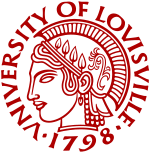 | |
Former names | Jefferson Seminary (1798–1829) Louisville Medical Institute (1837–1840) Louisville College (1840–1846) |
|---|---|
| Type | Public |
| Established | 1798 |
| Endowment | $719.8 million (2019)[1] |
| Budget | $1.3 billion[2] |
| President | Neeli Bendapudi |
| Provost | Beth Boehm[3] |
Academic staff | 1,776 Full-time and 764 Part-time[4] |
Administrative staff | 4,585 |
| Students | 21,430 (Fall 2019)[4] |
| Undergraduates | 15,641 (Fall 2019)[4] |
| Postgraduates | 5,789 (Fall 2019)[4] |
| Location | , , United States |
| Campus | Urban Belknap: 345 acres HSC: 62 acres Shelby: 233 acres Total: 640 |
| Colors | Red and Black[5] |
| Athletics | NCAA Division I – ACC |
| Nickname | Cardinals |
| Affiliations | ORAU APLU CUMU |
| Mascot | Cardinal Bird |
| Website | www |
 | |
Louisville is classified among "R1: Doctoral Universities – Very high research activity".[9] The University of Louisville School of Medicine is touted for the first fully self-contained artificial heart transplant surgery[10] as well as the first successful hand transplantation in the United States.[11] The University Hospital is also credited with the first civilian ambulance, the nation's first accident services, now known as an emergency department (ED), and one of the first blood banks in the US.[12]
Louisville is also known for its Louisville Cardinals athletics programs. Since 2005, the Cardinals have made appearances in the NCAA Division I men's basketball Final Four in 2005, 2012, and 2013 (vacated), football Bowl Championship Series Orange Bowl in 2007 (champions) and Sugar Bowl in 2013 (champions), the College Baseball World Series 2007, 2013, 2014, 2017 and 2019, the women's basketball Final Four in 2009 (runner-up), 2013 (runner-up), and 2018, and the men's soccer national championship game in 2010.[13] The Louisville Cardinals Women's Volleyball program has three-peated as champions of the Big East Tournament (2008, 2009, 2010), and were Atlantic Coast Conference Champions in 2015 and 2017. Women's track and field program has won Outdoor Big East titles in 2008, 2009 and 2010 and an Indoor Big East title in 2011.
History
Founding and early years: 1798–1845
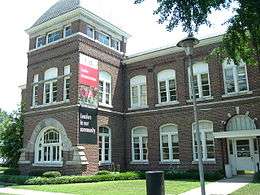
The University of Louisville traces its roots to a charter granted in 1798[14] by the Kentucky General Assembly to establish a school of higher learning in the newly founded town of Louisville. It ordered the sale of 6,000 acres (24 km²) of South Central Kentucky land to underwrite construction, joined on April 3, 1798 by eight community leaders who began local fund raising for what was then known as the Jefferson Seminary. It opened 15 years later and offered college and high school level courses in a variety of subjects. It was headed by Edward Mann Butler from 1813 to 1816, who later ran the first public school in Kentucky in 1829 and is considered Kentucky's first historian.[15]
Despite the Jefferson Seminary's early success, pressure from newly established public schools and media critiques of it as "elitist" would force its closure in 1829.[15]
Eight years later, in 1837, the Louisville City council established the Louisville Medical Institute at the urging of renowned physician and medical author Charles Caldwell. As he had earlier at Lexington's Transylvania University, Caldwell rapidly led LMI into becoming one of the leading medical schools west of the Allegheny Mountains. In 1840, the Louisville Collegiate institute, a rival medical school, was established after an LMI faculty dispute. It opened in 1844 on land near the present day Health sciences campus.
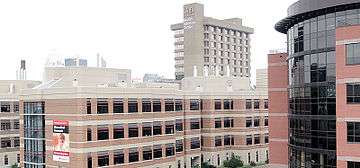
As a public municipal university: 1846–1969
In 1846, the Kentucky legislature combined the Louisville Medical Institute, the Louisville Collegiate Institution, and a newly created law school into the University of Louisville, on a campus just east of Downtown Louisville. The LCI folded soon afterwards. The university experienced rapid growth in the 20th century, adding new schools in the liberal arts (1907), graduate studies (1915), dentistry (1918), engineering (1925), music (1932) and social work (1936).
In 1923, the school purchased what is today the Belknap Campus, where it moved its liberal arts programs and law school, with the medical school remaining downtown. The school had attempted to purchase a campus donated by the Belknap family in The Highlands area in 1917 (where Bellarmine University is currently located), but a citywide tax increase to pay for it was voted down. The Belknap Campus was named after the family for their efforts. In 1926, the building that would later be dedicated as Grawemeyer Hall, was built.[16]
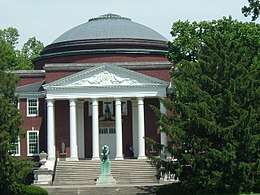
In 1931, the university established the Louisville Municipal College for Negroes on the former campus of Simmons University (now Simmons College of Kentucky), as a compromise plan to desegregation. As a part of the university, the school had an equal standing with the school's other colleges. It was dissolved in 1951 when the university desegregated.[17]
During World War II, Louisville was one of 131 colleges and universities nationally that took part in the V-12 Navy College Training Program which offered students a path to a Navy commission.[18]
In the second half of the 20th century, schools were opened for business (1953), education (1968), and justice administration (1969).
As a public state university: 1970–present
Talk of Louisville joining the public university system of Kentucky began in the 1960s. As a municipally funded school (meaning funding only came from the city of Louisville), the movement of people to the suburbs of Louisville created budget shortfalls for the school and forced tuition prices to levels unaffordable for most students. At the same time, the school's well established medicine and law schools were seen as assets for the state system. Still, there was opposition to the university becoming public, both from faculty and alumni who feared losing the small, close-knit feel of the campus, and from universities already in the state system who feared funding cuts. After several years of heated debate, the university joined the state system in 1970, a move largely orchestrated by then Kentucky governor and Louisville alumnus Louie Nunn.[19]
The first years in the public system were difficult, as enrollment skyrocketed while funding was often insufficient. Several programs were threatened with losing accreditation due to a lack of funding, although schools of nursing (1979) and urban & public affairs (1983) were added.
John W. Shumaker was named the university's president in 1995. Shumaker was a very successful fund raiser, and quickly increased the school's endowment from $183 to $550 million. He developed the REACH program[20] to encourage retention. In 1997, he hired athletics director Tom Jurich, who restored the athletics program and raised over $100 million to raze abandoned factories and old parking lots next to campus and replace them with on-campus athletic facilities, which vastly improved the aesthetics of the Belknap Campus. Academically, Louisville moved closer to parity with the state's flagship University of Kentucky as retention rates and research funding increased, and average GPAs and ACT scores were much higher for incoming freshman.
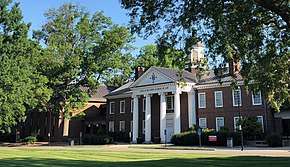
James R. Ramsey, the university's 17th president, continued the endowment and fund raising growth started by Shumaker. However, Ramsey added more emphasis on improving the physical aspects of the Belknap Campus. To this end, he started a million dollar "campus beautification project" which painted six overpasses on the Belknap Campus with a University of Louisville theme and planted over 500 trees along campus streets, and doubled the number of on-campus housing units. The university's federal research funding also doubled under Ramsey, and three buildings were built for nanotechnology and medical research. The university's graduation rate also increased from 30 percent in 1999 to 52 percent in 2012.
On June 17, 2016, Kentucky Governor Matt Bevin announced that the entire Board of Trustees of the university would be immediately disbanded and replaced and that Ramsey would be stepping down,[21] and this was confirmed in a statement issued by Ramsey on the same day.[22] Ramsey offered his resignation at a Board of Trustees meeting on July 27, 2016, which was accepted by the board. In December 2016, the university was placed on academic probation by its accrediting agency, the Southern Association of Colleges and Schools, over concerns that Governor Matt Bevin's actions had "violated rules that require that universities be independent".[23] The probation was lifted a year later.[24] The governor's actions were initially blocked by a judge but supported by new legislation passed by the Kentucky legislature in early 2017.[25]
In the summer of 2017, the university again came into the national spotlight as a series of scandals became public. The university's foundation, the organization that manages its endowment and investments, reported "millions of dollars in unbudgeted spending, unapproved activities and endowment losses" in an audit. The National Collegiate Athletic Association (NCAA) suspended the head coach of the men's basketball team, Rick Pitino, for five games after an investigation revealed that a university employee paid escorts to strip and have sex with players and recruits.[26] Shortly after the NCAA announced its findings and penalties, the Federal Bureau of Investigation and the office of the United States Attorney for the Southern District of New York announced the arrest of 10 individuals connected with a "pay for play" scheme connected to sportswear manufacturer Adidas and many institutions, including Louisville. Pitino was subsequently fired.
From 1895 to 2016, the university's Belknap Campus featured a Confederate monument, built before the campus grew to surround the land on which it stood. Commemorating the sacrifices of Confederate veterans who died in the American Civil War, it was erected by the Muldoon Monument Company in 1895 with funds raised by the Kentucky Woman's Confederate Monument Association. Due to controversy in 2016, the statue was moved from its original location to Brandenburg, Kentucky. Relocation started in November and was completed in mid-December.
Neeli Bendapudi became the University of Louisville's 18th President on May 15, 2018.
.jpg)
Innovations
Through its School of Medicine and University Hospital Louisville is known for its innovations in the field of medicine, including:
| Advance | Year |
|---|---|
| World's first self-contained artificial heart transplant[10] | 2001 |
| World's first successful hand transplant[11] | 1999 |
| Development of autotransfusion[12] | 1935 |
| First emergency department[12] | 1911 |
Academics
The University of Louisville offers bachelor's degrees in 70 fields of study, master's degrees in 78, and doctorate degrees in 22. According to the National Science Foundation, Louisville spent $176 million on research and development in 2018, ranking it 125th in the nation.[27]
Rankings
| University rankings | |
|---|---|
| National | |
| ARWU[28] | 156–171 |
| Forbes[29] | 431 |
| THE/WSJ[30] | 373 |
| U.S. News & World Report[31] | 192 |
| Washington Monthly[32] | 162 |
| Global | |
| ARWU[33] | 601–700 |
| U.S. News & World Report[34] | 544 |
U.S. News & World Report's 2020 edition ranked University of Louisville's undergraduate program tied for 192nd among all national universities and tied for 95th among public ones.[35] Forbes Magazine ranks the University 431st among 650 universities, colleges, and service academies; 147th for public colleges, 87th for colleges in the American South and 182nd best U.S. research university in 2019.[36]
Admissions
Admission to Louisville is considered "selective" by U.S. News & World Report.[37] A total of 9,430 applications were received for the freshmen class entering Fall 2015; 6,758 applicants were accepted (71.7%), and 2,797 enrolled.[38] Men constituted 50.9% of the incoming class; women 49.1%.[38]
Among freshman students who enrolled in Fall 2015, SAT scores for the middle 50% ranged from 490–620 for critical reading, and 510–620 for math.[38] ACT composite scores for the middle 50% ranged from 22–29.[38] The average high school GPA for incoming freshmen was 3.60.[38]
| 2016 | 2015 | 2014 | 2013 | 2012 | 2011 | |
|---|---|---|---|---|---|---|
| Applicants | N/A | 9,430 | 9,711 | 9,142 | 8,441 | 7,892 |
| Admits | N/A | 6,758 | 6,979 | 6,496 | 6,440 | 5,738 |
| % Admitted | N/A | 71.7 | 71.9 | 71.1 | 76.3 | 72.7 |
| Enrolled | N/A | 2,797 | 2,887 | 2,855 | 2,705 | 2,569 |
| Average GPA | N/A | 3.60 | 3.55 | 3.53 | 3.49 | 3.46 |
| SAT Range * | N/A | 1000–1240 | 1010–1250 | 1010–1260 | 1010–1260 | 990–1250 |
| ACT Range * | N/A | 22–29 | 22–28 | 22–28 | 22–28 | 21–28 |
| * middle 50% SAT out of 1600 |
Schools and colleges
The university consists of 12 schools and colleges:
- College of Arts and Sciences[43] (1907)
- College of Business[44] (1953)
- College of Education and Human Development[45] (1968)
- Graduate School[46] (1918)
- J. B. Speed School of Engineering (1925)
- Kent School of Social Work[47] (1936)
- Louis D. Brandeis School of Law (1846)
- School of Dentistry[48] (1887)
- University of Louisville School of Medicine (1837)
- School of Music[49] (1932)
- School of Nursing[50] (1979)
- School of Public Health and Information Sciences[51] (1919–1924; re-established in 2002)
UPS tuition reimbursement and Metropolitan College
In addition to their nationwide partial tuition reimbursement programs, UPS (United Parcel Service) offers Louisville (along with Jefferson Community and Technical College) students who work overnight at Worldport, the company's worldwide air hub at Louisville International Airport, full tuition reimbursement through a program called Metropolitan College. This program also offers reimbursement for $65.00 of book costs for each class, and awards bonus checks to students in good standing at the end of each semester and upon reaching certain credit hour milestones. Employees additionally are eligible for full health insurance coverage.[52] Currently over 75 percent of the workers at the air hub are students.[53]
Honors Program
The University of Louisville also has an Honors Program under the direction of Joy Hart. Incoming freshmen can apply to be in the Honors Program if they meet the following requirements: a 3.5 cumulative high school GPA and a 29 on their ACT. Current students can apply for the Honors Program if they are able to maintain a cumulative GPA of 3.35 or higher. Courses through the Honors Program focus on reading, writing and discussion. Students in the Honors Program also benefit from priority registration for classes, smaller class sizes, and unique study abroad opportunities.[54]
Campuses
The university has three campuses in the Louisville area, the Belknap, the Health Science, and the Shelby. It also has an International Campus in Panama City, Panama, as well as various satellite facilities in the state of Kentucky and abroad:
Belknap Campus
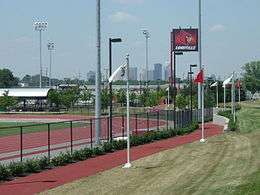
Acquired in 1923, the Belknap Campus is the school's main campus. It is located three miles (5 km) south of downtown Louisville in the Old Louisville neighborhood. It houses seven of the 12 academic colleges and features one of the casts of Auguste Rodin's The Thinker in front of the main administrative building, Grawemeyer Hall. The grounds of the campus were originally used as an orphanage, several of the original buildings used.[55]
The Belknap Campus has expanded greatly in recent years, with land housing abandoned factories in the area being purchased and redeveloped. Projects built since 1998 include Cardinal Stadium and adjacent Trager Center fieldhouse, Owsley B. Frazier Cardinal Park (which includes Ulmer Stadium for softball, Trager Stadium for field hockey, Cardinal Track and Soccer Stadium, Bass-Rudd Tennis Center, locker rooms, a playground and a cushioned walking path), Jim Patterson Stadium for baseball, Ralph R. Wright Natatorium, Owsley Brown Frazier Sports medicine Center, and a lacrosse stadium. With new parking at Cardinal Stadium, non-resident parking was moved there and the parking lots near campus were redeveloped with new dormitory buildings, including the Bettie Johnson Apartments,[56] Kurz Hall, Minardi Hall, and Community Park.[57]
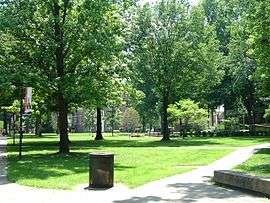
Other points of interest on the Belknap Campus include the Rauch Planetarium;[58] the Covi Gallery of the Hite Art Institute, named for the painter Marcia Hite and her husband Allen;[59] and the final resting place for former U.S. Supreme Court Justice Louis D. Brandeis under the portico in the Brandeis Law School. Surrounded by, but not part of the campus, is the Speed Art Museum, a private institution that is affiliated with the University of Louisville. The Kentucky State Data center, the state's official clearing house for census data and estimates, is located next to Bettie Johnson Hall.
Since 2008 the school has purchased three large tracts of land adjacent to the Belknap Campus, 55 acres (220,000 m2) to the school's northwest campus, 17 acres (69,000 m2) to the school's east campus – south of Hahn and 39 acres (160,000 m2) south of the Speed School of Engineering. New student housing has been completed on one of the northwest segments with student parking slated for the other. A new engineering and applied sciences research park is planned for the land south of the Speed School of Engineering. It serves as the centerpiece of a Signature Tax Increment Financing (TIF) district, designed to stimulate economic growth in an area around the university's Belknap campus. The TIF district covers more than 900 acres stretching from Belknap Campus south to the Watterson Expressway. The Kentucky Economic Development Finance Authority recently approved the TIF, paving the way for what could be an estimated $2.6 billion over 30 years.
 Student Activities Center and Clock Tower
Student Activities Center and Clock Tower Belknap Campus from the Eastern Parkway overpass
Belknap Campus from the Eastern Parkway overpass.jpg) Rauch Planetarium
Rauch Planetarium Lutz Hall is home to the departments of Sociology, Art History, Geography, Anthropology, and Engineering
Lutz Hall is home to the departments of Sociology, Art History, Geography, Anthropology, and Engineering
Belknap Campus development projects
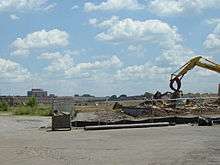
In 2009, the university unveiled its new master plan for the next 20 years with efforts from the University of Louisville Foundation and other affiliate partners. Several important projects under construction or planned at that time included a new student recreation center, soccer stadium, new residence halls and academic buildings. Furthermore, the reconstruction of the I-65 ramps to the Belknap Campus, converting the four lanes of Eastern Parkway into a two-lane road with bike lanes and a landscaped median to improve pedestrian access to the Speed School, the moving of several university offices to allow the existing facilities at Arthur Street and Brandeis Avenue to be converted to commercial property and restaurants. The Yum! Center (a men's basketball and volleyball practice facility) was completed in the fall of 2007. A 12,000-square-foot (1,100 m2) Olympic sports training/rehab center adjacent to Trager Stadium is also under construction. Additionally, Trager Plaza, a small plaza with a fountain, statue, and garden has been built with donations by the Trager Family on the south part of campus. The $37.5 million Student Recreation Center, located on the Fourth Street corridor along the western border of campus, opened in October 2013. The Province, The Bellamy and Cardinal Towne are three new student housing developments built to the southwest of campus, near the recreation center. All three were built by private developers, and The Province was built in tandem with Louisville's properties. In the short term, university provost Shirley Willihnganz expects the university to continue partnerships with private entities to build student housing.
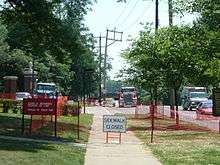
On another note several athletic facilities are being renovated, and the new $8 million academic center will be located beneath the Norton Terrace at the south end of Cardinal Stadium. It will be centrally located between two of the university's cornerstone buildings, the Swain Student Activities Center and Cardinal Stadium. It will have seating capacity for over 5,300 fans and will feature a 15,500 square foot training center that will include identical locker rooms for each team, coaches' offices and a sports medicine training room. This stadium will be the second largest project the athletic department has undertaken behind Cardinal Stadium. Furthermore, a $4 million expansion of Jim Patterson Stadium includes the addition of 1,500 chair back seats, two-tiered ground level terraces, a visiting team locker room, and a 6,400 square foot terrace atop the chair back seats connecting the first and third base sides. The new Jim Patterson Stadium will have a total capacity of 5,000. Along with the $2.75 million expansion of the university’s softball stadium will feature a team clubhouse with a locker room, a video room, and a players' lounge. The Dan Ulmer Stadium will see the addition of 200 chair back seats, bringing the seating capacity to 1,000. The project also will add a 2,380 square foot fan terrace wrapping around the back of the stadium, as well as a new press box that will more than double its current size.
Health Sciences Campus
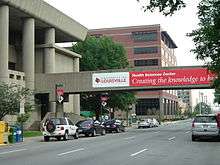
The University Health Sciences Center, also called the med campus, is located just east of Downtown Louisville in the Louisville medical park which contains two other major hospitals and several specialty hospitals, and it houses the remaining five colleges. This is the school's original campus, being continuously used since 1846, although none of the original buildings remain. Buildings of note on the HSC include the fourteen story Medical Research Tower and the ten-story University Hospital. Construction is finished for a recently opened, downtown Louisville Cardiovascular Research Innovation Institute building to be directed by a researcher, Stuart Williams from the University of Arizona; and an eight-story, $70 million biomedical research building. Faculty and students also work with neighboring hospitals including Norton Children's Hospital, as well as outreach programs throughout Kentucky, including in Paducah, Campbellsville, and Glasgow.
 Cardiovascular Innovation Institute
Cardiovascular Innovation Institute The University’s Medical Research Tower
The University’s Medical Research Tower Baxter Research Building on the Louisville Health Sciences Campus
Baxter Research Building on the Louisville Health Sciences Campus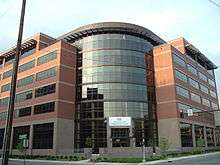 University Hospital Medical Plaza, completed in June 2008
University Hospital Medical Plaza, completed in June 2008
Health Sciences Campus development projects
The University of Louisville Health Sciences Campus has seen a large amount of new development in the past decade, include the completion of 3 new buildings (Baxter Research Complex, Cardiovascular Research Tower, and the Jackson Street Medical Plaza). Work is ongoing on the Biolab Research Tower, with a January 2009 completion date projected.
In 2007 Louisville announced plans to create a nine-acre medical research park on the so-called Haymarket property roughly bounded by Market, Preston, Brook, and Jefferson Streets, along I-65 in Downtown Louisville, now called the Nucleus Research Park, with 1,000,000 square feet (93,000 m2) of research space. Nucleus, Kentucky's Life Science and Innovation Center, was established in 2008 by the University of Louisville Foundation to integrate university resources with those of the region to transform Louisville into a major life science research hub. Nucleus is assisting in the development of Louisville’s Health Science Campus downtown as well as improving the physical and economic health of Kentucky and the region.
Nucleus' work is integral to the development of the research park currently underway at Louisville’s Haymarket 30-block property in downtown Louisville. Nucleus Innovation Park will house multiple facilities in close proximity to expedite collaboration and shared expertise among researchers and companies creating a vibrant technology business district along the city's healthcare/university/riverfront corridor. The project is expected to cost $300 million and would be constructed from 2009 to 2017. A 200,000-square-foot, eight-story, $18 million building, is the first in a series of structures, broke ground in July 2011, and is expected to open in June 2013.[60]
An important project adjacent to the Downtown Health Sciences Campus was the conversion of the Clarksdale Housing Complex into a new mixed income development called Liberty Green.
Shelby Campus
The 230-acre (0.93 km2) Shelby Campus is located on Shelbyville Road near Hurstbourne Parkway in Eastern Louisville. This campus was originally the home of Kentucky Southern College, a Southern Baptist liberal arts college that operated from 1961 to 1969.[61] After the college folded, it transferred all its assets and liabilities to the university. It currently only has three buildings which are used for night classes and seminars, although construction of a $34.6-million Center for Predictive Medicine, a Level 3 biosafety facility, is in the works.[62] The Shelby Campus is also home for the building which houses the Information Technology Resource Center (ITRC) for homeland security. The ITRC conducts communications and IT research for the U.S. Department of Homeland Security as well as seminars and training in emergency preparedness and response. When completed, the impressive ShelbyHurst Office Campus will have over 1.5 million square feet of modern office space managed, developed and leased by NTS Development Co., in partnership with the University of Louisville Foundation. The first three projects are in full swing.[63]
The university’s Shelby campus is undergoing a major renovation, with two new entrances to the campus off Hurstbourne Parkway. The overall goal is to develop 108 acres (0.44 km2) of the 230-acre (0.93 km2) campus for business, office, technology and research use, now known as the ShelbyHurst Research and Office Park. The university will spend $7.9 million on the road improvements on the campus. The roadway improvements began in August 2008, with work on a new four-lane boulevard through the campus, bordered by bike lanes, sidewalks, and will be heavily landscaped. The 600 North Hursbourne – Transformation is evident at the busy northeast corner of ShelbyHurst with the completion of 600 North. The LEED-certified, 125,000-square-foot office building is 80 percent leased and serves as corporate headquarters to Churchill Downs, NTS, Semonin Realtors and Stifel Nicolaus.
500 and 700 North Hurstbourne Planning and design is currently underway for 500 and 700 North, ShelbyHurst's newest properties. With construction set to begin later this year, these properties will have between 100,000 and 130,000 square feet of Louisville's most prestigious office space. ShelbyHurst was designed around a four-lane boulevard through the campus bordered by bike lanes and wide attractive sidewalks. Special attention was given to enhancing green space and improving the life of the surrounding community. The green design of the entire development, combined with the convenience of a new boulevard and modern throughways, will facilitate driving, walking and biking through the campus.[64]
International Campus
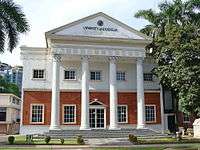
The University of Louisville runs a sister campus[65] in Panama City, Panama, which has an MBA program.[66] The full-time program takes around 16 months to complete and enrolls about 200 students. It is currently ranked the 4th best MBA program in Latin America.[66]
The university also offers professional MBA programs in Athens, Hong Kong, Singapore and other parts of Asia. Their collaboration partner in Singapore is Aventis School of Management.
Other facilities
Louisville operates the Moore Observatory in Oldham County, an astronomical observatory. There are also plans to purchase several hundred acres in Oldham County for the school's equine program.
The president's mansion, Amelia Place, is located at 2515 Longest Avenue.[67] It is the former residence of railroad executive Whitefoord Russell Cole.[68]
Libraries
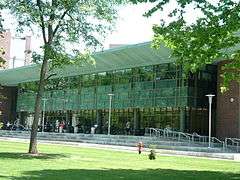
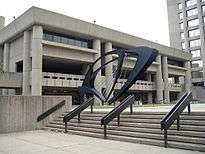
The University of Louisville library system is a member of the Association of Research Libraries.[69] Louisville’s main library branch is the William F. Ekstrom Library, which opened in 1981. The four-story building finished an expansion in March 2006, which increased its total size to 290,000 square feet (27,000 m2) and shelving capacity to over 1.3 million books. It is one of only five universities in the U.S. to have a robotic retrieval system,[70] which robotically places books in humidity-free bins. The University of Louisville libraries were the seventh academic institution in North America to have such a facility.
There are five other libraries at the university, with a combined total of more than 400,000 volumes of work:
- Archives and Special Collections[71]
- The Margaret M. Bridwell Art Library[72]
- Dwight Anderson Memorial Music Library[73]
- Kornhauser Health Sciences Library[74]
- Brandeis Law School Library[75]
In 2009, the Kersey Library at the J. B. Speed School of Engineering was converted to an academic building named the Duthie Center for Engineering.[76] The library's collection was fully integrated into Ekstrom Library on January 15, 2007.
Enrollment statistics
Undergraduate student body
- Total enrollment is 22,293 as of Fall 2012.
- 76.2% of students are Kentucky residents.
- 44.0% of students are from Jefferson County (down from 64% in 1995)
- Average ACT Score: 25.2 as of Fall 2013 (up from 20.7 in 1995)
- 6-year graduation rate: 53.5% (2012) (up from 33% in 2004)
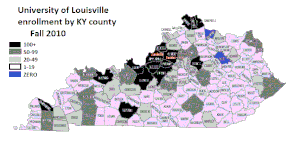
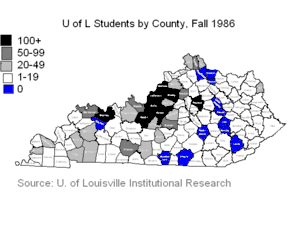
| Rank County | County | 2015 Enrollment[78] |
|---|---|---|
| 1 | Jefferson (Louisville) | 9,733 |
| 2 | Oldham (La Grange) | 842 |
| 3 | Hardin (Elizabethtown) | 654 |
| 4 | Bullitt (Shepherdsville) | 601 |
| 5 | Kenton (Covington) | 569 |
| 6 | Fayette (Lexington) | 436 |
| 7 | Boone (Florence) | 441 |
| 8 | Shelby (Shelbyville) | 272 |
| 9 | Daviess (Owensboro) | 267 |
| 10 | Campbell (Newport) | 251 |
Top five US states (other than KY) for enrollment, Fall 2006
Note: *Panama enrollment includes Louisville’s Panama City program,[65] which offers a full-time MBA program.[79] Note: **Beginning in 1998, as part of a reciprocity agreement with Indiana University Southeast in New Albany, Indiana, Louisville began offering in-state tuition to residents of Clark, Floyd, Harrison, Washington, and Crawford counties in Indiana (residents of Metro Louisville wishing to attend IUS receive the same benefit)[80]
Residence halls
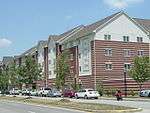
The university has 12 housing options on its campuses:
- Cardinal Towne – It has an assortment of restaurants on the 1st floor.
- Community Park
- Bettie Johnson Hall
- Herman & Heddy Kurz Hall
- University Pointe
- Medical Dental Apartments
- University Tower Apartments
- Louisville Hall
- Miller Hall
- Billy Minardi Hall
- Threlkeld Hall
- Unitas Tower – Named after football legend Johnny Unitas who attended the school from 1950 to 1954, the tower is easily visible from many parts of campus and is located by the School of Music.
Media
The university’s student maintained radio station, WLCV,[81] began airing in 1968 and is broadcast on the internet and on a low level AM signal that reaches most of the Belknap Campus.[82] Louisville holds a prominent role in the city of Louisville's "Public Radio Partnership" which features three NPR stations under one roof, including the school's namesake WUOL-FM which broadcasts classical music. The school also holds one-third of the seats on the Partnership's board of directors.
There is also an independent student-run weekly newspaper, The Louisville Cardinal. The newspaper was founded in 1926, and has maintained financial and editorial independence since 1980. The newspaper is overseen by a board of local media professionals and run by a student editor-in-chief.
Inside the university’s Student Activities Center is The Floyd Theatre, a 228-seat movie theater operated by the Student Activities Board. The theater is capable of running both 35 mm prints and DVD projection.
Greek life
|
Sororities
|
Fraternities
|
Notable people
Alumni
.jpg)
The University has more than 144,000 alumni residing in the United States and around the world.[83]
The University claims as alumni, one winner of the Pulitzer Prize for Theatre (Marsha Norman, BFA 1969), a 10-time NFL pro-bowler (Johnny Unitas), the 2016 Heisman Trophy winner (Lamar Jackson), the Majority Leader of the United States Senate (Mitch McConnell, BA 1964), the first female director of the CIA (Gina Haspel, BA 1978), the former Chancellor of the University of California, Berkeley (Chang-Lin Tien, MEng 1983) and many others including governors, senators, mayors, US Attorneys and CEOs.
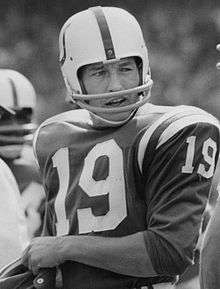
Athletics

The Louisville Cardinals (commonly referred to as "the Cards") are the student athletes representing the university. There are 13 women's and 10 men's teams, all of which participate in the Atlantic Coast Conference. Louisville was invited to the ACC on November 28, 2012 and began play in 2014. The Cardinals are well known nationally in men's basketball with two national championships(2013 vacated)and 9 Final Four appearances(2013 vacated), ranking 5th in NCAA Tournament wins, 9th in winning percentage, and from 2nd to 5th in annual attendance every year since 1984. For the 2015–16 season, the men's basketball team held a self-imposed postseason ban due to a sex scandal involving recruits and former players.[84] The NCAA put the Louisville men's basketball program on four years probation in June 2017 and imposed a number of penalties including a suspension of head coach Rick Pitino, a reduction of scholarships and 123 vacated games as a result of its investigation into the program's stripper scandal.[85]
In recent years other Cardinal teams have gained national prominence. The women's basketball team, coached by Jeff Walz and led by first team All-American Shoni Schimmel, has been to two straight Sweet 16s and have been ranked in the top 10. In December 2008 the Cardinals broke the Big East paid attendance record when 17,000 fans filled Freedom Hall to watch the Cards defeat rival Kentucky, and later that season advanced to the NCAA championship game, losing to Connecticut. The Cardinals returned to the NCAA final behind Native American star Shoni Schimmel in 2013, losing again to Connecticut, The following season, the Cardinals filled the KFC Yum! Center with over 22,000 fans, including an estimated 1,500 Native Americans from 40 states, for the final scheduled home game of the graduating Schimmel. Other Louisville teams with recent post season success includes track and field (two individual national championships), volleyball (consecutive Sweet 16 appearances and a three-peat as Big East Tournament Champions from 2008 to 2010, and Atlantic Coast Conference Champions in 2015) and baseball (two College World Series appearances and consecutive Big East conference titles). The volleyball team has also accomplished achievements such as Head Coach Anne Kordes being named Coach of the Year in 2015, Senior Setter for Louisville, Katie George being named Atlantic Coast Conference Player of the Year, and Freshman Libero, Molly Sauer being named Freshman of the Year and Defensive Player of the Year. All Louisville locally broadcast games airing on the school's flagship affiliate WHAS-TV Louisville are televised on every cable provider in Kentucky.
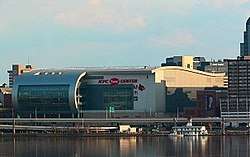
See also
References
- As of June 30, 2019. "U.S. and Canadian 2019 NTSE Participating Institutions Listed by Fiscal Year 2019 Endowment Market Value, and Percentage Change in Market Value from FY18 to FY19 (Revised)". National Association of College and University Business Officers and TIAA. Retrieved April 23, 2020.
- "About UofL". University of Louisville.
- "Who We Are — Office of the Executive Vice President and University Provost". louisville.edu.
- https://nces.ed.gov/collegenavigator/?q=University+of+Louisville&s=all&id=157289
- "Primary Color Palette". University of Louisville. Retrieved April 16, 2017.
- "UofL Mission statement". Archived from the original on July 10, 2006. Retrieved June 8, 2006.
- "UofL Fall '05 Enrollment by County" (PDF). Archived from the original (PDF) on December 1, 2007. Retrieved June 8, 2006.
- "UofL Fall '05 Enrollment by State" (PDF). Archived from the original (PDF) on December 1, 2007. Retrieved July 7, 2006.
- "Carnegie Classifications Institution Lookup". carnegieclassifications.iu.edu. Center for Postsecondary Education. Retrieved July 25, 2020.
- Altman, Lawrence K. (July 4, 2001). "Self-Contained Mechanical Heart Throbs for First Time in a Human". The New York Times. Retrieved August 8, 2015.
- Altman, Lawrence K. (January 26, 1999). "Doctors in Louisville Perform Nation's First Hand Transplant". The New York Times. Retrieved August 8, 2015.
- Brown, Russ (Summer 2000). "30 Ways We've Changed the World". U of L Magazine. Retrieved August 8, 2015.
- "Akron wins first NCAA soccer title". espn.com. Retrieved December 17, 2016.
- "UofL History". Archived from the original on July 10, 2006. Retrieved June 8, 2006.
- Botkins, Shirley (2001). "Public Schools". In Kleber, John E. (ed.). The Encyclopedia of Louisville. Lexington, Kentucky: University Press of Kentucky. pp. 735–737. ISBN 0-8131-2100-0. OCLC 247857447. Retrieved September 7, 2016.
- "Grawemeyer Hall — Campus Tours". louisville.edu.
- Cox, Dwayne; Morison, William (2000). The University of Louisville. Lexington, KY: University Press of Kentucky. p. 89. ISBN 0813121426. Retrieved October 12, 2017.
- "Alumni Association Scholarships". Louisville, Kentucky: University of Louisville. 2011. Retrieved September 25, 2011.
- "Going State". Retrieved June 8, 2006.
- "About REACH". Reach.louisville.edu. Retrieved August 5, 2009.
- Barton, Ryland (June 17, 2016). "U of L President James Ramsey To Step Down". WFPL. Retrieved June 17, 2016.
- "Statement to the campus community". University of Louisville. June 17, 2016. Retrieved June 17, 2016.
- Wolfson, Andrew (December 7, 2016). "Accrediting agency puts U of L on probation". The Courier-Journal. Retrieved December 17, 2016.
- Seltzer, Rick (December 6, 2017). "Accreditor Lifts Louisville Probation". Inside Higher Ed. Retrieved November 12, 2019.
- Seltzer, Rick (January 6, 2017). "Kentucky Legislature Moves to Revamp Louisville Board". Inside Higher Ed. Retrieved November 12, 2019.
- Seltzer, Rick (June 28, 2017). "Battling for Basketball". Inside Higher Ed. Retrieved November 12, 2019.
- "Table 20. Higher education R&D expenditures, ranked by FY 2018 R&D expenditures: FYs 2009–18". ncsesdata.nsf.gov. National Science Foundation. Retrieved July 25, 2020.
- "Academic Ranking of World Universities 2020: National/Regional Rank". Shanghai Ranking Consultancy. Retrieved August 15, 2020.
- "America's Top Colleges 2019". Forbes. Retrieved August 15, 2019.
- "U.S. College Rankings 2020". Wall Street Journal/Times Higher Education. Retrieved September 26, 2019.
- "Best Colleges 2020: National University Rankings". U.S. News & World Report. Retrieved September 8, 2019.
- "2019 National University Rankings". Washington Monthly. Retrieved August 20, 2019.
- "Academic Ranking of World Universities 2020". Shanghai Ranking Consultancy. 2020. Retrieved August 15, 2020.
- "Best Global Universities Rankings: 2020". U.S. News & World Report LP. Retrieved October 22, 2019.
- U.S. News & World Report. 2020 https://www.usnews.com/best-colleges/university-of-louisville-1999/overall-rankings. Retrieved September 19, 2019. Missing or empty
|title=(help) - "University of Louisville". Forbes. 2019. Retrieved September 19, 2019.
- "U.S. News Best College Rankings 2017". U.S. News & World Report. Retrieved February 24, 2017.
- "University of Louisville Common Data Set 2015–2016, Part C" (PDF). University of Louisville.
- "University of Louisville Common Data Set 2014–2015, Part C". University of Louisville.
- "University of Louisville Common Data Set 2013–2014, Part C". University of Louisville.
- "University of Louisville Common Data Set 2012–2013, Part C". University of Louisville.
- "University of Louisville Common Data Set 2011–2012, Part C". University of Louisville.
- "Home – The College of Arts and Sciences". louisville.edu. Retrieved August 8, 2015.
- "UofL College of Business". louisville.edu. Retrieved August 8, 2015.
- "College of Education and Human Development". louisville.edu. Retrieved August 8, 2015.
- "Home – School of Interdisciplinary and Graduate Studies". louisville.edu. Retrieved August 8, 2015.
- "My Folder – Kent School of Social Work". louisville.edu. Retrieved August 8, 2015.
- "School of Dentistry". louisville.edu. Retrieved August 8, 2015.
- "School of Music". louisville.edu. Retrieved August 8, 2015.
- "School of Nursing". louisville.edu. Retrieved August 8, 2015.
- "Home – School of Public Health and Information Sciences". louisville.edu. Retrieved August 8, 2015.
- "Metropolitan College". Retrieved June 8, 2006.
- "UPS fuels economic gains". Courier. May 18, 2006. Retrieved June 8, 2006.
- "About Honors – University Honors Program". louisville.edu. Retrieved September 29, 2015.
- "University of Louisville Buildings Once Housed Homeless Children". Archived from the original on September 4, 2006. Retrieved January 16, 2008.
- "Bettie Johnson Apartments". Allen & O'Hara Development, LLC. Archived from the original on April 15, 2007. Retrieved August 8, 2015.
- "Welcome to Community Park at UofL". University of Louisville. Archived from the original on June 24, 2007. Retrieved August 8, 2015.
- "Gheens Science Hall & Rauch Planetarium". University of Louisville. Retrieved August 4, 2016.
- "Hite Art Institute – UofL Libraries". Retrieved March 22, 2017.
- Green, Ed (August 3, 2007). "Making hay: Haymarket project would represent nearly $300 million investment on East Jefferson". Business First of Louisville. Retrieved March 2, 2009.
- "UofL — Kentucky Southern College records". Special.library.louisville.edu. Archived from the original on June 30, 2010. Retrieved October 22, 2010.
- "Center for Predictive Medicine > University of Louisville". louisville.edu.
- "theitrc.com". Retrieved August 5, 2009.
- Staff (August 12, 2008). "Work to start soon on improving Shelby Campus infrastructure". University of Louisville. Retrieved August 9, 2015.
- "Annual Study Abroad Program in Panama". University of Louisville. Retrieved August 26, 2012.
- "U of L Business School earns new rankings". October 24, 2005. Retrieved June 8, 2006.
- "Event Calendar: Amelia Place". University of Louisville. Retrieved October 25, 2017.
- "Whitefoord Cole Will Be Buried in Nashville Today. Special Train to Bring Body for Service". The Tennessean. November 19, 1934. pp. 1, 3. Retrieved October 25, 2017 – via Newspapers.com.
- "Member Libraries". Retrieved March 2, 2009.
- "Robotic Retrieval System". Archived from the original on January 8, 2008. Retrieved June 8, 2006.
- "Archives & Special Collections – UofL Libraries". Retrieved October 11, 2017.
- "Art Library – UofL Libraries". Retrieved October 11, 2017.
- "Dwight Anderson Music Library – UofL Libraries". Retrieved October 11, 2017.
- "Kornhauser Health Sciences Library – UofL Libraries". Retrieved October 11, 2017.
- "Law Library Home Page – Louis D. Brandeis School of Law Library". Retrieved September 7, 2016.
- "UofL officials dedicate Duthie Center for Engineering". University of Louisville. November 13, 2009. Retrieved September 7, 2016.
- "U of L Profile". Archived from the original on June 18, 2012. Retrieved August 26, 2012.
- "UofL - Just the Facts, 2014–15" (PDF). Archived from the original (PDF) on October 5, 2015. Retrieved October 3, 2015.
- "University of Louisville-Panama". Archived from the original on December 27, 2007. Retrieved March 2, 2009.
- "UofL Magazine: Journal". Retrieved March 2, 2009.
- "WLCV Student Radio". University of Louisville. Archived from the original on March 2, 2012. Retrieved August 4, 2016.
- Greenwell, Patrick (March 18, 2008). "Frequency: After initial static, campus radio receives good reception". The Louisville Cardinal. Archived from the original on July 26, 2011. Retrieved March 18, 2008.
- "Faculty Handbook". louisville.edu. Retrieved June 25, 2018.
- "Louisville self-imposes postseason ban for men's hoops in 2016". ESPN. February 5, 2016. Retrieved August 12, 2016.
- "Coach suspension". Retrieved June 15, 2017.
External links
| Wikimedia Commons has media related to University of Louisville. |
